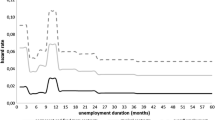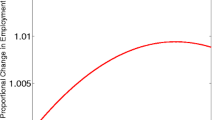Abstract
Using a Cox proportional hazard model that allows for a flexible time dependence in order to incorporate business cycle effects, we analyze the determinants of re-employment probabilities of young workers in the USA from 1978–1989. We find considerable changes in the chances of young workers finding jobs over the business cycle despite the fact that personal characteristics of those starting jobless spells do not vary much over time. Therefore, government programs that target specific demographic groups may change individuals’ positions within the queue of job seekers, but may only have a more limited impact on average re-employment probabilities. Living in an area with high local unemployment reduces re-employment chances as does being in a long spell of non-employment. However, the damage associated with being in a long spell seems to be reduced somewhat if a worker is unemployed in an area with high overall unemployment.










Similar content being viewed by others
Notes
We have not included more than five years of labor market data for any of the observations in our sample. It would have been possible for those who finished school in the early years of the cohort (e.g. 1979, 1980) to have more years of data but then we would have ended up requiring the earlier school leavers not to have returned to school for a longer period of time than for later school leavers.
Plots of the quartiles are available from the authors on request.
The computational costs of these procedures are quite high. Every evaluation of the partial likelihood function is an operation of order N 2 where N is the number of spells. Since we have around 6,000 spells the optimization routines take a very long time. However, as suggested to us by Bruce Meyer, this may be reduced by averaging over a sample from the risk set, rather than averaging over the entire risk set.
Therefore one might interpret the receipt of unemployment benefit as another measure of previous labor market experience that picks up whether or not the most recent employment spell was long enough to make the individual eligible for unemployment insurance.
References
Andersen PK, Gill R (1982) Cox regression model for counting processes: a large sample study. Ann Stat 10:1100–1120
Baker M (1992) Unemployment duration: compositional effects and cyclical variability. Am Econ Rev 82(1):313–321
Barsky R, Miron J (1989) The seasonal cycle and the business cycle. J Polit Econ 97(3):503–534
Blanchard O, Diamond P (1990) The cyclical behavior of the gross flows of U.S. workers. Brookings Pap Econ Act 2:85–155
Blank R, Card D (1991) Recent trends in insured and uninsured unemployment: is there an explanation? Q J Econ 106(4):1157–1189
Cox DR (1972) Regression models and life tables. J R Stat Soc B 34:187–220
Davis S, Haltiwanger J, Schuh S (1996) Job creation and destruction. MIT Press, Cambridge, Massachusetts
Dynarski M, Sheffrin SM (1990) The behavior of unemployment durations over the cycle. Rev Econ Stat 72(2):350–356
Elbers C, Ridder G (1982) True and spurious duration dependence: the identification of the proportional hazard. Rev Econ Stud 49(3):403–410
Flinn C, Heckman JJ (1982) Models for the analysis of labor force dynamics. In: Baseman R, Rhodes G (eds) Advances in econometrics. JAI, Greenwich, Connecticut
Heckman JJ, Singer B (1984) The identifiability of the proportional hazard model. Rev Econ Stud 52(2):231–243
Honore B (1990) Simple estimation of a duration model with unobserved heterogeneity. Econometrica 58(2):453–474
Imbens GW (1994) Transition models in a non-stationary environment. Rev Econ Stat 86(4):703–720
Lancaster T (1979) Econometric methods for the duration of unemployment. Econometrica 47(4):939–956
Lancaster T (1990) The econometric analysis of transition data. Cambridge University Press, Cambridge, UK
Layard R, Nickell SJ, Jackman R (1991) Unemployment: macroeconomic performance and the labour market. Oxford University Press, Oxford, UK
Lynch LM (1989) The youth labor market in the eighties: determinants of re-employment probabilities for young men and women. Rev Econ Stat 71(1):37–45
Lynch LM (1991) The role of off-the-job versus on-the-job training for the job mobility of women workers. American Economic Review Papers and Proceedings 81(2):151–156
Lynch LM (1992) Private sector training and its impact on the earnings of young workers. Am Econ Rev 82(3):299–312
Lynch LM (1994) (ed) Training and the private sector: international comparisons. University of Chicago Press, Chicago
Meyer B (1990) Unemployment insurance and unemployment spells. Econometrica 58(4):757–782
Moffit R (1985) Unemployment insurance and the distribution of unemployment spells. J Econom 28(1):85–101
Mortenson D, Pissarides C (1994) Job creation and job destruction in the theory of unemployment. Rev Econ Stud 61(3):397–415
Pissarides C (2000) Equilibrium unemployment theory, 2 edn. MIT Press, Cambridge, Massachusetts
Ridder G (1990) The non-parametric identification of generalized accelerated failure-time models. Rev Econ Stud 57(2):167–182
Ridder G, Verbakel W (1983) On the estimation of the proportional hazard model in the presence of heterogeneity. report 22–83, faculty of Actuarial Science and Econometrics, Free University, Amsterdam
Shimer R (2005) The cyclicality of hires, separations, and job-to-job transitions. Federal Reserve Bank of St. Louis Review July/August, 493–508
Solon G (1985) Work incentive effects of taxing unemployment benefits. Econometrica 53(2):295–306
Van den Berg G (2001) Duration models: specification, identification and multiple duration. In: Heckman JJ, Leamer E (eds) The handbook of econometrics, vol V. North Holland, Amsterdam
Van den Berg G, Van der Klaauw B (2001) Combining micro and macro unemployment duration data. J Econom 102(2):271–309
Van den Berg G, Van Ours JC (1996) Unemployment dynamics and duration dependence. J Labor Econ 14(1):100–125
Acknowledgements
We would like to thank Phil Johnson for excellent research assistance on this project and Olivier Blanchard, Bruce Meyer, Jonathon Thomas, two anonymous referees, and participants in seminars at the NBER, MIT, and the University of British Columbia for comments on an earlier draft.
Author information
Authors and Affiliations
Corresponding author
About this article
Cite this article
Imbens, G.W., Lynch, L.M. Re-employment probabilities over the business cycle. Port. Econ. J. 5, 111–134 (2006). https://doi.org/10.1007/s10258-006-0006-5
Received:
Accepted:
Published:
Issue Date:
DOI: https://doi.org/10.1007/s10258-006-0006-5




